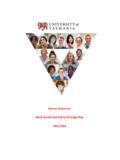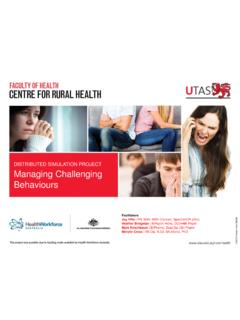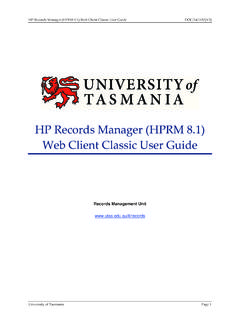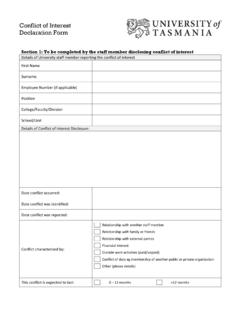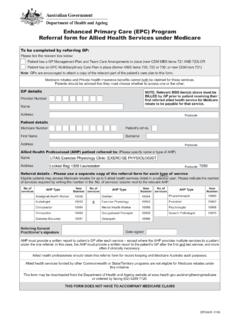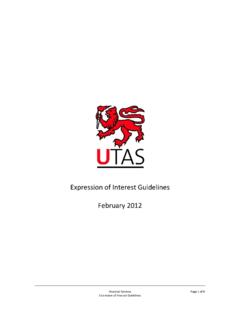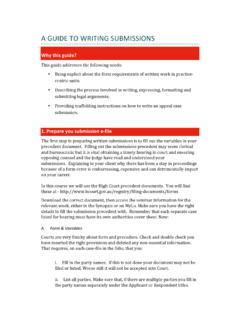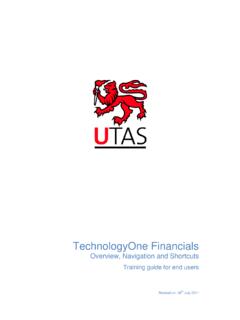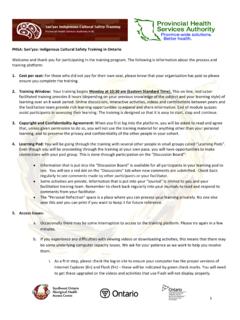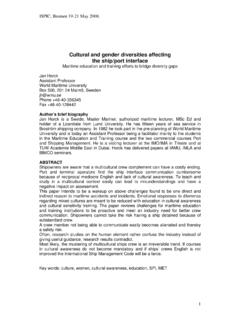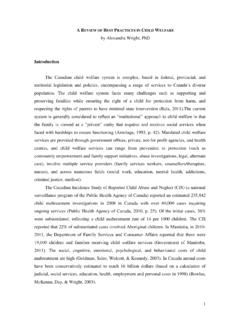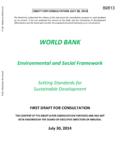Transcription of cultural safety no assault on a person’s identity
1 cultural safety - WHAT DOES IT MEAN FOR OUR WORK PRACTICE? Author : Robyn Williams, Lecturer in indigenous Health, FATSIS, NTU Address : c/o Faculty of Aboriginal & Torres Strait Islander Studies, Northern Territory University Darwin NT 0909 ph (08) 89 467237 fax (08) 89 466345 email: Abstract : Culturally safe service delivery is crucial in enhancing personal empowerment; and therefore should promote more effective and meaningful pathways to self-determination for indigenous people. Little has been said about encouraging people from indigenous groups into the respective professional health and education discipline(s) , and how to assist in providing a safe environment, which includes cultural safety .
2 This is a phrase originally coined by Maori nurses which means that there is no assault on a person s identity . The people most able or equipped to provide a culturally safe atmosphere are people from the same culture. Much of the current debate is centred on the need to move on from the short term, cost effective, quick fix approach to indigenous issues, driven by economic imperatives, the clamouring of industry and conservative, hegemonic practices. In order to genuinely address the challenges of indigenous health and education, the issue of cultural safety cannot be avoided.
3 Critical reflection on experiential knowledge and defining or framing a debate on cultural safety is essential. INTRODUCTION: The issue and concept of cultural safety , has been around for some time, indeed indigenous people have been talking about it for quite some time. So what does it mean and why do some people think that it is important and needs to be discussed? Why is there so still so much unwillingness to genuinely engage in discourse in relation to the issue? As a term used in academic circles, cultural safety first came to prominence in the late 1980s and early 1990s.
4 Important milestones included conference papers presented on the work spearheaded by Maori nurses like Ramsden. 1 What she wrote about cultural safety in nursing education struck a cord with this author especially in terms of issues that were impacting on her work practice as a lecturer of indigenous students. These issues included students ongoing experiences of ongoing institutional racism, especially in the education system and lack of appropriate tertiary education opportunities. One definition of cultural safety that has emerged from years of reflection, argument and discussion between indigenous and non- indigenous staff and students, is that it means: more or less - an environment, which is safe for people; where there is no assault , challenge or denial of their identity , of who they are and what, they need.
5 It is about shared respect, shared meaning, shared knowledge and experience, of learning together with dignity, and truly listening. Why is this challenging for so many non- indigenous people in particular? This paper does not claim to have the answers. There are only ideas, thoughts and questions - formed over the years through readings and discussions with students and colleagues. 1 Ramsden, IH (1992) cultural safety in nursing education in Aotearoa at the Year of indigenous Peoples Conference, Brisbane.
6 cultural safety - What does it mean for our work practice? 2 During the years of working in indigenous education; the author became increasingly frustrated with the seemingly (ever increasing) chasm/barrier between what was expected of a lecturer and what the indigenous students wanted and needed. The work seemed to becoming harder and more complex in some ways in the urban setting than the work in remote communities. At one particular faculty planning meeting that the author participated in, the discussion highlighted a lack of appreciation of the factors that affected indigenous students.
7 It became apparent to the author that one of the critical issues that still framed the debates was that of cultural safety . This was also a critical factor involved in other cross cultural curriculum development the author has been involved in, most particularly in the indigenous health and then local government areas. The author felt that no-one could move forward really, personally or professionally, until it had been worked out what cultural safety meant, why it was so important, and what it meant for individual and organisational work practice. cultural safety : Much has been written in recent times of the need to develop strategies within service delivery, which would provide opportunities for practitioners to enable the development and acceptance of cultural diversity.
8 In other words, it is stated that culturally appropriate programs/approaches are crucial in enhancing personal empowerment and as a result, promote more effective service delivery (be it education, health or whatever) for indigenous people. However little has really been said about actually encouraging indigenous people into the respective health and education discipline(s) for example, in order to assist providing a safe environment; a safe environment which includes cultural factors. The people most able or equipped to provide a culturally safe atmosphere are people from the same culture.
9 This would seem to be stating the obvious, so why is there so much resistance to promoting implementation of strategies designed to achieve this? cultural safety - What does it mean for our work practice? 3So far, culturally safe environments for indigenous peoples are rare, in any area of service delivery. Unfortunately, it does not appear that there will be sufficient numbers2 of indigenous peoples as health care professionals (for example) to provide widespread health care and one would presume - cultural safety . Some non- indigenous people try to ensure a culturally safe atmosphere.
10 However, one would have to ask the obvious question as to whether members of one culture can provide a 'culturally safe' environment for another group. Why? In beginning to answer questions to do with cultural safety and/or evaluate approaches; a matter of priority for any organisation involved in service delivery for indigenous clients has to be to critically evaluate their work practice. This is also a critical element in determining pathways to genuine empowerment for the aforementioned clients and all the indigenous stakeholders. Otherwise, the rhetoric of self-determination, social justice and reconciliation will never become reality.
